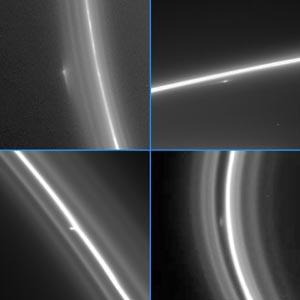
It's Official
Here's a link to The Register with the article.
The Cassini imaging team has released a slew of previously unseen pictures from the Saturn ring and moon system, to coincide with the 37th annual meeting of the Division of Planetary Sciences of the American Astronomical Society held in Cambridge.
The scientists have identified new features in the rings, including some that are slightly mysterious. For instance, in the image below, you can make out small clumps in the ring structure. But what are they?
Scientists have long speculated that small moons, hidden among the many strands of the F-ring could be responsible for the odd structure of the region. The question is, are these clumps just disturbances in the ring structure caused by interactions with larger moons nearby such as Prometheus, or are they moons in their own right?
The imaging team explains that working out the answer is tricky, precisely because perturbations from nearby moons make the orbits in the region so complicated. This makes it hard to say whether sightings are the same object seen many times, or many, short-lived objects caught on camera during their brief existence.
Other images are less mysterious, but just as interesting. Recent snaps of the D-ring have been compared with older images from the Voyager missions. The results reveal that the structure of the ring has changed over time. In particular, one strand of the ring, known as D72, which was the brightest feature in the D-ring a quarter of a century ago has become much dimmer, and has moved inwards by about 200km.
Sort of puts a dent into the notion these rings of Saturn have been around forever and a day. I don't know about you, but i always thought that they'd been there since Saturn was formed.

Other related news:
BBC News
USA Today
Washington Post
While scientists puzzle over what caused the changes, their observations could reveal something about the age and lifetime of the rings.
Cassini-related discoveries were discussed Monday at a meeting of the American Astronomical Society's division of planetary sciences in Cambridge, England.
"I don't think Saturn's rings will disappear anytime soon, but this tells us how the rings are evolving and how long they might last, " deputy project scientist Linda Spilker said in a telephone interview from England.
Scientists are interested in Saturn's rings because they are a model of the disk of gas and dust that initially surrounded the sun. Studying them could yield important clues about how the planets formed from that disc 4.5 billion years ago.
What if they find out that they're a lot more recent than people thought? That'll cause a stink.

In other news, Cassini makes a flyby of Titan once more today, looking for lakes.

No comments:
Post a Comment